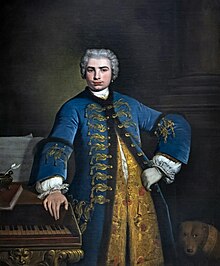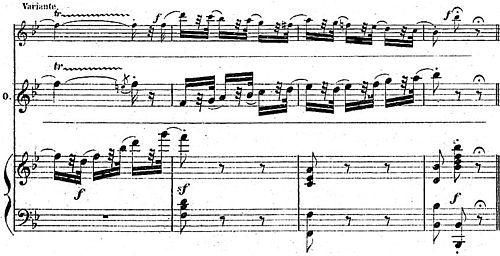Coloratura

Coloratura(UK:/ˌkɒlərəˈtjʊərə/KOL-ər-ə-TURE-ə,US:/ˌkʌl-/KUL-,Italian:[koloraˈtuːra];lit. 'coloring',fromLatincolorare'to color')[1]is an elaboratemelodywithruns,trills,wideleaps,or similarvirtuoso-like material,[1][2]or apassageof such music. Operatic roles in which such music plays a prominent part, and singers of these roles, are also called coloratura.[3]Its instrumental equivalent isornamentation.Coloratura is particularly found in vocal music and especially inoperaticsinging of the 18th and 19th centuries.
History
[edit]The termcoloraturawas first defined in several early non-Italian music dictionaries:Michael Praetorius'sSyntagma musicum(1618);Sébastien de Brossard'sDictionaire de musique(1703); andJohann Gottfried Walther'sMusicalisches Lexicon(1732). In these early texts "the term is dealt with briefly and always with reference to Italian usage".[4]
Christoph Bernhard(1628–1692) definedcoloraturain two ways:[4]
- cadenza:"runs which are not so exactly bound to the bar, but which often extend two, three or more bars further [and] should be made only at chief closes" (Von der Singe-Kunst, oder Maniera,c. 1649)
- diminution:"when an interval is altered through several shorter notes, so that, instead of one long note, a number of shorter ones rush to the next note through all kinds of progressions by step or leap" (Tractatus compositionis,c. 1657)
The term was never used in the most famous Italian texts on singing:Giulio Caccini'sLe Nuove musiche(1601/2);Pier Francesco Tosi's,Opinioni de' cantori antichi e moderni(1723);Giovanni Battista Mancini'sPensieri, e riflessioni pratiche sopra il canto figurato(1774);Manuel García'sMémoire sur la voix humaine(1841), andTraité complet de l’art du chant(1840–47); nor was it used by the English authorsCharles Burney(1726–1814) andHenry Fothergill Chorley(1808–1872), both of whom wrote at length about Italian singing of a period when ornamentation was essential.[4]
Modern usage
[edit]The termcoloraturais most commonly applied to the elaborate and florid figuration or ornamentation inclassical(late 18th century) andromantic(19th century, specificallybel canto) vocal music. However, early music of the 15th, 16th and 17th centuries, and in particular,baroque musicextending up to about 1750, includes a substantial body of music for which coloratura technique is required by vocalists and instrumentalists alike. In the modern musicological sense the term is therefore used to refer to florid music from all periods of music history, both vocal and instrumental.[4]For example, in Germany the termcoloratura(German:Koloratur) has been applied to the stereotypical and formulaic ornamentation used in 16th‑century keyboard music written by a group of German organ composers referred to as the "colorists"(German:Koloristen).[2]
Despite its derivation from Latincolorare( "to color" ), the term does not apply to the practice of "coloring" the voice,i.e.altering the quality ortimbreof the voice for expressive purposes (for example, the technique ofvoix sombréeused byGilbert Duprezin the 1830s).[4]
Vocal ranges
[edit]The term is not restricted to describing any one range of voice. All female and male voice types may achieve mastery of coloratura technique. There are coloratura parts for all voice types in different musicalgenres.[3]
Nevertheless, the termcoloratura,when used without further qualification, normally means acoloratura soprano.This role, most famously typified by the Queen of the Night in Mozart'sThe Magic Flute,[5]has a high range and requires the singer to execute with great facility elaborate ornamentation and embellishment, including running passages,staccati,andtrills.A coloratura soprano has the vocal ability to produce notes above high C (C6) and possesses atessituraranging from A4to A5or higher (unlike lower sopranos whose tessitura is G4–G5or lower).[citation needed]
 |
Richard Miller names two types of soprano coloratura voices (the coloratura and the dramatic coloratura)[6]as well as a mezzo-soprano coloratura voice,[7]and although he does not mention the coloratura contralto, he includes mention of specific works requiring coloratura technique for the contralto voice.[8]
Examples of coloratura music for different voice ranges include:
- Mozart'sAllelujah(fromExsultate, jubilate) may be arranged for and sung by a properly trainedcontralto,mezzo-sopranoorsoprano.The piece was written forsoprano castrato.
- TheariaEvery valley shall be exaltedfromHandel'sMessiahis an example of a coloratura piece fortenor.
- Each singer of a major role inRossini's operas must have a secure coloratura technique.[citation needed]
- Osmin, a character in Mozart'sThe Abduction from the Seraglio,is a coloratura role for abasso.
- Agitata da due venti( "Agitated by two winds" ) a coloratura soprano aria, fromAntonio Vivaldi's operaGriselda.
- Naqui All'Affanno - Non Piu Mestaa coloratura contralto rondo, fromRossini's operaLa Cenerentola.
See also
[edit]Citations
[edit]- ^abOxford American Dictionaries.
- ^abApel (1969), p. 184.
- ^abSteane, J. B.; Jander, Owen, "Coloratura" in Sadie (1992)1:907.
- ^abcdeJander, Owen; Harris, Ellen T. "Coloratura" inGrove Music Online,grovemusicArchived2008-05-16 at theWayback Machine.Retrieved 27 November 2006.
- ^Randel (1986), p. 180.
- ^Miller (2000), pp. 7–9.
- ^Miller (2000), pp. 12–13.
- ^Miller (2000), p. 13.
Works cited
[edit]- Apel, Willi, ed. (1969).Harvard Dictionary of Music,second edition. Cambridge, Massachusetts: The Belknap Press ofHarvard University Press.ISBN978-0-674-37501-7.
- Miller, Richard (2000).Training soprano voices.New York: Oxford University Press.ISBN978-0-19-513018-8.
- Randel, Don Michael, ed.; Apel, Willi, ed. (1986).New Harvard Dictionary of Music.Cambridge, Massachusetts: The Belknap Press of Harvard University Press.ISBN978-0-674-61525-0.
- Sadie, Stanley, ed. (1992).The New Grove Dictionary of Opera(four volumes). London: Macmillan.ISBN978-1-56159-228-9.
